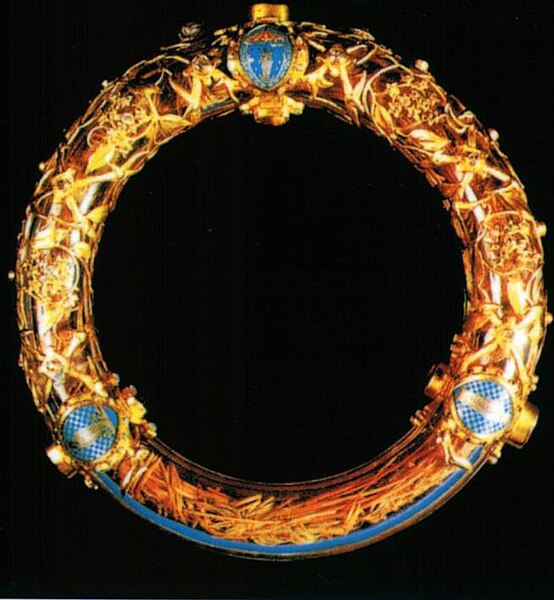According to the New Testament, a woven crown of thorns was placed on the head of Jesus during the events leading up to his crucifixion. It was one of the instruments of the Passion, employed by Jesus' captors both to cause him pain and to mock his claim of authority. It is mentioned in the gospels of Matthew, Mark and John, and is often alluded to by the early Church Fathers, such as Clement of Alexandria, Origen and others, along with being referenced in the apocryphal Gospel of Peter.
Christ carrying the cross with the crown of thorns, as painted by El Greco, c. 1580s
A purported relic of the Crown of Thorns, received by the French King Louis IX from Emperor Baldwin II.
Nuremberg 16th-century silver medal of Jesus Christ with a crown of thorns by Valentin Maler.
Christ Carrying the Cross by Andrea Solario, 1513, portrays the crown of thorns
The Passion is the short final period before the death of Jesus, described in the four canonical gospels. It is commemorated in Christianity every year during Holy Week.
Christ Crowned with Thorns by Matthias Stom (c. 1633–1639) shows Jesus in his Passion as the "Lord of Patience" with the crown of thorns and scepter reed, being mocked by Roman soldiers.
16th century sculpture of suffering Christ [cs], Cheb, Czechia
Icon of the Passion, detail showing (left) the Flagellation and (right) Ascent to Golgotha (fresco by Theophanes the Cretan, Stavronikita Monastery, Mount Athos).
Crucifixion by Albrecht Altdorfer (c. 1526)






![16th century sculpture of suffering Christ [cs], Cheb, Czechia](https://upload.wikimedia.org/wikipedia/commons/thumb/5/5f/Bolestn%C3%BD_Kristus_%28po%C4%8D._16._stol.%29%2C_Cheb.jpg/399px-Bolestn%C3%BD_Kristus_%28po%C4%8D._16._stol.%29%2C_Cheb.jpg)

